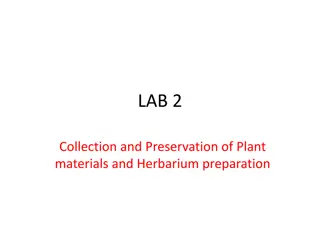Field Visits and Herbarium Techniques in Plant Taxonomy
This material covers the field visits and specimen collection process in plant taxonomy, emphasizing the need for complete specimens with tools required. It explains the pressing, drying, mounting, and preservation techniques involved in creating herbarium specimens for study and research purposes.
Download Presentation

Please find below an Image/Link to download the presentation.
The content on the website is provided AS IS for your information and personal use only. It may not be sold, licensed, or shared on other websites without obtaining consent from the author.If you encounter any issues during the download, it is possible that the publisher has removed the file from their server.
You are allowed to download the files provided on this website for personal or commercial use, subject to the condition that they are used lawfully. All files are the property of their respective owners.
The content on the website is provided AS IS for your information and personal use only. It may not be sold, licensed, or shared on other websites without obtaining consent from the author.
E N D
Presentation Transcript
Harischandra Post Graduate College ,Varanasi (Mahatma Gandhi Kashi Vidyapith, Varanasi Faculty Of Science Department of Botany Topic Plant Taxonomy Sub Topic Herbarium Techniques Subject Botany Class M.Sc. II semester Paper Name III(Angiosperm: Taxonomy, Morphology And Economic Botany) Creator Name Dr. Devashish Singh Mob. No. 9415820140 Email. ID singhdevashish85@gmail.com Date of Creation - 02.09.2020
Field visits and specimen collection: A complete specimen possesses all parts including root system, flowers and fruits. Therefore, regular field visits are necessary to obtain information at every stage of growth and reproduction of a plant species. In the fields, the tools required are mainly trowel (digger) for digging roots, scissors and knife for cutting twigs, a stick with a hook for collection of parts of tall trees, a field note book, polythene bag, old newspaper and magazines. To avoid damage during transportation and preservation at least 5-G specimens of a plant should by collected. The collected specimens are transported in a vasculum (specimen box) to prevent willing, livery collected specimen must be tagged with a field number and necessary information should be recorded in a field note book.
Pressing and drying: The specimens are spread out between the folds of old newspapers or blotting sheets avoiding overlapping of parts. The larger specimen may folded in N or W shapes. The blotting sheets with plant specimen should be placed in the plant press for drying. After 24 to 48 hours the press is opened.
Mounting: The dried specimens are mounted on herbarium sheets of standard size (41 x 29 cm). Mounting is done with the help of glue, adhesive or cello-tape. The bulky plant parts like dry fruits seeds, cones etc. are dried without pressing and are put in small envelops called fragment packets. Succulent plants are not mounted on herbarium sheets but are collected in 4% formalin or FAA (Formalin Acetic Alcohol).
Preservation: The mounted specimens are sprayed with fungicides like 2% solution of mercuric chloride.
Labeling The most important item to consider when determining the academic value of a specimen is the label. If the label does not give sufficient information "where, when and by whom that plant was collected" you cannot get sufficient information from the specimen. A specimen without a label cannot be used for academic research. Even if you want to donate a specimen without a label to a herbarium, the herbarium may decline the donation. Each person has a different way to write a label but the label must provide the minimum amount of information: locality , date of collection , collector's name . The typical size of a label is 3-4 in x 3.5-6 in (7-10 cm x 9-15 cm). You should use regular paper or neutral high quality paper. Write the information using durable non-fading ink.
1. Title : Organization or individual that holds the specimen. Origin or locality of the plant collected. The title can be omitted. 2. Species name : Scientific or common name. If the names are unknown, don't enter them. Someone else can find them for you or you can find them by checking in various photo reference books or with The Plant List. 3. Determined by and Date : Enter the name of the person who identified the plant (use the scientific name of the plant) and the date. 4. Locality : Enter the location (country, city, name of the mountain, river, pond, island, etc.) in detail. The place name may be changed over time, so it would be best to also record the latitude and longitude of the location. You can find the latitude and longitude by looking up the GPS data or use a map service.
Habitat and Altitude : Enter the type of habitat (e.g., forest, grassland, marsh, riverbank, seacoast, etc.) and the altitude. Read the altitude from a map or use an altimeter. If you cannot find the precise altitude, enter, for example, "c. 100m" or "50 100m". 6. Date : Enter the date as "Apr. 15, 2020" or "15-IV-2020", so that it can be read by anyone. 7. Collector's name and specimen number : Write the collector's name. The specimen number is used for reference and allows the collector to manage and record specimens. Each specimen may have a different number. If you make multiple specimens or duplicate specimens from one individual organism, you will need to assign the same specimen number to them. 8. Notes : When collecting a plant, include on the label additional information about the specimen such as tree height, grass height, flower color/scent, fruit color/scent, habitat characteristics (e.g., vegetation, number of individual organisms, etc.)
Storage: Properly dried, pressed and identified plant specimens are placed in thin paper folds (specimen covers) which are kept together in thicker paper folders genus overs), and finally they are incorporated into the herbarium cupboards in their proper position according to a well known system of classification. In India Bentham and Hooker s system of classification is used for this purpose. Type specimens are generally stored in separate and safe places.
Herbariums in India Forest Research Institute (FRI), Dehradun Herbarium of the Indian Botanic Gardens, Kolkata Herbarium of the National Botanic Gardens, Lucknow Madras Herbarium, Agricultural College and Research Institute, Coimbatore Herbarium of the Division of Botany, IndianAgricultural Research Institute, (I.A.R.I.), New Delhi
Herbaria of the World 1. Museum of Natural History, Paris 2. Royal Botanic Gardens, Kew 3. Komarov Botanical Institute Leningrad 4. Conservatory and Botanical Garden, Geneva 5. Combined Herbaria, Harvard University, Cambridge 6. New York Botanical Garden, Bronx 7. U.S. National Herbarium, Washington 8. British Museum of Natural History, London 9. Natural History Museum, Vienna 10. Missouri Botanical Garden, Saint Louis 11. Field Museum of Natural History, Chicago 12. National Botanical Garden of Belgium, Brussels 13. Botanical Garden and Botanical Museum, Berlin 14. Academy of Natural Science, Philadelphia 15. Royal Botanic Garden, Edinburgh
REFERENCES 1) Preparation of Herbarium Specimen for Plant Identification and Voucher Number : Kottapalli S., Venumadhav K. , Krishna H. , Jamir K. ,Roxburghia-Vol-6_Article-2.pdf https://www.researchgate.net/publication/309159781_PREPARATION_OF_HERBARIUM_SPECIMEN_FO R_PLANT_IDENTIFICATION_AND_VOUCHER_NUMBER/link/5801e6b508ae310e0d9c3ab7/download 2) arnoldia.arboretum.harvard.edu/1968-28-notes-on-making-an- herbarium.pdf 3) www.anbg.gov.au/brochures/Atherton-Herbarium.pdf 4) www.biologydiscussion.com/angiosperm/taxonomy- angiosperm/herbarium-functions-kinds-and-importance- systematic-botany/34711























